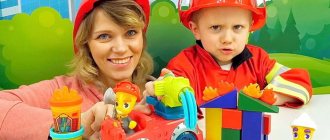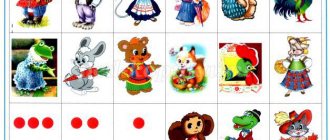Summary of the plot lesson “Zoo”. Role-playing game.
"Zoo"
The plot is a role-playing game.
Target:
generalize and systematize children’s ideas about animals in our country and other countries: cultivate a culture of behavior, cognitive interest in natural objects, develop children’s memory, logical thinking, and imagination. Activate vocabulary (veterinarian, tour guide)
Tasks:
1. Educational:
— Contribute to the expansion of knowledge about animals, about their appearance, to characterize them from memory;
— Help children learn new professions: “Veterinarian”, “Tour guide”;
— Stimulate children’s creative activity in the game, develop the ability to develop the plot of the game using building material;
2. Developmental:
- develop children’s speech, consolidate sound pronunciation;
— enrich vocabulary;
— train vocabulary;
3. Educational:
- to form friendly, good relationships between children during the game;
- cultivate a kind attitude towards animals, love for them and care for them
Preliminary work:
conversations about animals using illustrations about the zoo, looking at the album “Wild Animals”, making and guessing riddles about animals, reading fiction about animals, depicting animals with stencils, coloring images of animals.
Progress:
The melody from the film “Mother for the Baby Mammoth” is heard, the song of the baby mammoth
Educator:
Guys, have you heard this song?
Who sings it? (children's answers).
The baby mammoth sent us a letter, he asks for your help: to find his mother.
We'll try to find his mother at the zoo. Who can tell me what a zoo is? (children's answers).
A zoo is a place where animals living on Earth are kept and shown to visitors. Some animals are listed in the Red Book; there are very few of them on Earth; reserves have been organized for them, in which it is forbidden to hunt or kill animals and birds. But to catch them for the zoo with permission, so that people can see and know them
Educator:
Who works at the zoo?
Children:
Director - manages the work of the zoo Workers - care for the animals, feed them, clean the cages and the animals themselves
Builders – building a zoo for an animal
Cashier – sells tickets to visitors
A guide is a person who tells interesting stories about animals.
Driver – brings animals from different countries
Cook - prepares food for animals
Veterinarian – a doctor who treats animals
Educator:
Guys, let's order a bus and go to the zoo
(children build a bus from chairs, choose a driver and conductor, the bus ride is being reenacted)
Driver:
Who ordered a bus for a trip to the zoo? Please get on the bus.
Conductor: Dear passengers, please purchase tickets
Educator:
Guys, while you and I are driving, let’s guess riddles about the animals we might meet there.
- From head to toe
This predator is striped
Hidden and silent
And when he gets angry, he growls (tiger
)
- Long neck and long legs,
The animal is walking in alarm
Pinches leaves, visible to the enemy
He is afraid of being caught by a tiger and a lion ( giraffe
)
- He's probably ugly
Instead of a nose there is a fire hose.
Ears seem to be fanned
The height of a tower waved ( elephant
)
- There is a mane, but no hooves
And he does not neigh, but roars ( lion
)
- They jump briskly through the trees
Everyone is fooled at the zoo
They only see flaws in others
And their names are... ( monkeys)
- Strong, brave and playful
He walks with a shaggy mane,
But quickly hide in holes
He is a very formidable of animals ( lion
)
- From head to toe
This predator is striped
Hidden and silent
And when he gets angry, he growls ( tiger)
- He is neither a deer nor a bull
I'm used to living in hot countries
Unfriendly, hot-tempered, strict
It has one horn ( rhinoceros)
- When he's in a cage he's nice
There are many black spots on the skin
He is a beast of prey, although a little
Like a lion and a tiger, looks like a cat ( leopard)
- He is not an elephant, not a lion, not a bird
He lives in the river all year round,
Not afraid of the crocodile
He is reputed to be a fat barrel ( hippopotamus)
- It hides like a mask
Protective paint from all
Marked like a steamer
She walks across Africa ( zebra
)
- Long, menacing and toothy
Very scary and dangerous
And if you find yourself in the jungle
It's better not to meet him
He lives in the river all his life
Only the hippopotamus ( crocodile)
)
Educator:
Well guys, we have arrived at the place where we will have our future zoo. Since we don’t have a zoo in our city, we need to build one.
- What can it be built from (from cubes). The zoo has a director who oversees the work. I will be the director. We need to choose builders. Lenya and Lesha - today you will be builders. your task is to build a zoo
— What are the builders doing at the zoo? (children's answers)
- When you build it, you will be workers. What are the workers doing? (resettle the animals, clean the cages, feed the animals)
. Guys, get to work.
Educator:
And if animals get sick, who can treat them?
(children's answers)
- And a doctor for animals is a veterinarian. He watches the animals and treats them. Polina will be the veterinarian. Your task is to examine the animals. Grab your first aid kit and get to work.
The phone rings.
Educator:
Guys, they just called me on the phone and said that they are now bringing a lot of animals from different countries. Maybe among them there will be a mother of a baby mammoth. It is necessary to place the animals in cages and feed them
- Who prepares food for animals (children’s answers).
Our cook will be Yaroslav. Go cook some food.
The car horn sounds. A child in the role of a driver delivers a truck with animals.
Educator:
Tell me guys, are these animals wild or domestic?
(answers)
.
And now I suggest we show our animals to the veterinarian (the veterinarian examines the animals)
- Tell the doctor if all the animals are healthy. Then I propose to place our animals in cages. This is what workers do
— The zoo was built, the animals were settled, the veterinarian monitors their health. Do you want to go to the zoo on an excursion?
— In order to come to the zoo, what should we buy? (tickets)
— Where could you buy tickets? (at the register)
— Who sells tickets? (cashier).
Veronica will be the cashier. But the cashier will only sell tickets if you correctly name the baby animal depicted on the ticket.
(children receive tickets)
Educator:
Here we are at the zoo. The guide will tell us about the life of animals. Dasha, you will be a tour guide. Please tell me about some animal.
Giraffe
- the tallest animal on Earth. Its color is light yellow with black spots. They feed on plants, branches and leaves of trees. The giraffe's neck is long and flexible, it has horns on its head, and a short mane grows on its neck. In order for a giraffe to drink water, it needs to spread its legs wide apart to reach it. The coloring of its skin makes it practically invisible when it is in the shade of trees. He has sharp eyesight and keen hearing. A female giraffe gives birth to one baby with small horns. Giraffes live for about 15-25 years.
Monkey
- They have long hair. They love fruits, honey, tree bark, mushrooms, insects, and small animals. The arms are very long - twice as long as the legs. Animals move by swinging and jumping along tree branches. They walk on the ground relying on their feet and knuckles.
a lion
- king of beasts. Makes a roar or growl. He sleeps during the day and hunts at night. His dark golden or black brown mane gives him greatness. The luxurious mane is fully formed in males when they reach the age of 5-6 years. He spends his entire life in a pack. By food, lions understand almost anything that moves. Sometimes, lost by a waterfall, a lion can become prey to huge crocodiles.
Elephant
- one of the largest animals. Elephants have excellent hearing. In hot weather they use their ears as fans. Elephants have good eyesight; long eyelashes protect the animal's eyes from dust. Long tusks are nothing more than very large teeth that continue to grow throughout life. Elephants use them to dig up roots. Elephants eat grass, tree bark, shoots, leaves, and fruits. Elephants need a trunk to drink water from the river, pick leaves from tall trees and put them in their mouths, lift and carry heavy logs, pour water on themselves, and spank a naughty elephant calf. The legs are powerful and thick. The skin is wrinkled in folds. The female elephant gives birth to one calf, which weighs 120 kilograms.
Educator:
Guys, what animal do you think is suitable to be a mother for a baby mammoth
(answers)
- Of course, an elephant. I will write a letter to the baby mammoth that his mother is waiting for him at the zoo
- Oh guys (looks at his watch),
and it’s lunch time at our zoo, our animals are hungry, we need to feed them.
I suggest going to the table and seeing if the food for the animals is ready (
the workers feed the animals, and meanwhile the teacher tells the children that it is very dangerous to get close to cages with animals, you cannot feed them sweets, and do not make noise in the zoo)
Educator:
There is a photographer working in our zoo. If you want to take pictures near the animals, go up to the photographer (a child with a camera is taking pictures of children
)
- Guys, it’s time for us to go back to kindergarten. Get on the bus, let's go home
— Did you like the game “Zoo”?
— Which animals piqued your interest?
—What animals would you not like to meet?
— Do you think wild animals need our help as pets? Why can't you have wild animals in your apartment?
We didn’t even notice how we ended up in a group. You are all great, thank you!
Summary of the role-playing game “Bus trip to the zoo”
Summary of the role-playing game “A trip by bus to the zoo” in the senior group.
Target:
systematize children’s existing knowledge and skills about the rules of safe behavior in public places based on the role-playing game “Traveling by Bus to the Zoo.”
Tasks:
continue to develop in children the ability to perform game actions in accordance with the game plan; activate dialogic speech; encourage initiative and independence, strengthen friendly relationships during gaming activities.
Preliminary work:
a series of lessons from the “Safety” series; examination of illustrations on the topic: “Traffic rules”, “Modes of transport”, “Zoo”, “Animals of forests”, “Animals of hot countries”; reading fiction (stories, poems, riddles) S. Marshak “Zoo”, “Children in a Cage”; L. Shevchenko “At the Zoo”; K. Chukovsky “Aibolit”; didactic games: “Attention on the roads”, “Road signs”, “Safe walks”, “Who lives where?”, “Such different animals”, “Zoological lotto”; production of albums “Transport”, “Animals of hot countries”, “Animals of forests”; acquaintance with illustrations by S. Nikolaeva and N. Meshkova from the series “The World Around Us. Beasts"; conversations with children about visiting the zoo in the summer with their parents, about the professions of people working in the zoo; conversations about the characteristics of the animal world and other climatic zones.
Vocabulary work:
freight transport, passenger transport, conductor, driver; veterinarian, zoo, aviary, cashier.
Roles:
bus driver, conductor, cashier, “please”, “thank you”.
Subject-spatial environment:
toys - animals (at least 16 pieces), a designer to build enclosures, a model of a bus, a steering wheel for the driver, a conductor's bag, a model of a ticket office, tickets for the bus and to the zoo, "money".
Methods and techniques:
explanations, story, questions, playing out roles and game situations, riddles, the didactic game “Guess what sign”, the sedentary game “At the Bear in the Forest”.
Progress of the game
A teacher stands at the window with children
-November-late autumn has arrived. It’s very cold outside and everything in nature is preparing for winter. And I would really like to visit a place where you can see forest animals and animals of hot countries, regardless of the weather.
The children suggest going to the zoo. The teacher supports the children's initiative. Everyone together begins to build enclosures from the construction set and place animals (toys) in them, and set up a model of the cash register.
-How can you get to the zoo, maybe by car? (children, he is too small for us)
-But then on a truck? (Children trucks transport goods, not people)



